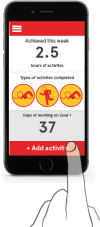Integrating Mobile-health, health coaching, and physical activity to reduce the burden of chronic low back pain trial (IMPACT): a pilot randomised controlled trial
- PMID: 30744606
- PMCID: PMC6371593
- DOI: 10.1186/s12891-019-2454-y
Integrating Mobile-health, health coaching, and physical activity to reduce the burden of chronic low back pain trial (IMPACT): a pilot randomised controlled trial
Abstract
Background: Low back pain is one of the most prevalent musculoskeletal conditions and the highest contributor to disability in the world. It is characterized by frequent relapses leading to additional care-seeking. Engagement in leisure physical activity is associated with lower recurrences and better prognosis and potentially reduced care-seeking. Our aim was to investigate the feasibility and preliminary efficacy of a patient-centred physical activity intervention, supported by health coaching and mobile health, to reduce care-seeking, pain and disability in patients with chronic low back pain after treatment discharge.
Methods: We conducted a pilot randomised controlled trial with blinded outcome assessment. Sixty-eight participants were recruited from four public outpatient physiotherapy departments and the general community in Sydney. The intervention group received a physical activity information booklet, plus one face-to-face and 12 telephone-based health coaching sessions. The intervention was supported by an internet-based application and an activity tracker (Fitbit). Control group (standard care) received the physical activity information booklet and advice to stay active. Feasibility measures included recruitment rate, intervention compliance, data completeness, and participant satisfaction. Primary outcomes were care-seeking, pain levels and activity limitation. Outcomes were assessed at baseline, 6-month follow-up and weekly for 6 months.
Results: Ninety potential participants were invited over 15 months, with 68 agreeing to take part (75%). Overall, 903 weekly questionnaires were answered by participants from a total of 1107 sent (89%). Participants were largely satisfied with the intervention (mean = 8.7 out of 10 on satisfaction scale). Intervention group participants had a 38% reduced rate of care-seeking (Incidence Rate Ratio (IRR): 0.62, 95% CI: 0.32 to 1.18, p = 0.14, using multilevel mixed-effects Poisson regression analysis) compared to standard care, although none of the estimates was statistically significant. No between groups differences were found for pain levels or activity limitation.
Conclusion: The health coaching physical activity approach trialed here is feasible and well accepted by participants and may reduce care-seeking in patients with low back pain after treatment discharge, although further evaluation with an adequately powered trial is needed.
Trial registration: Australian and New Zealand Trial Registry ACTRN12615000189527 . Registered prospectively on 26-02-2015.
Keywords: Health coaching; Low back pain; Mobile health; Physical activity; Randomized controlled trial.
Conflict of interest statement
Ethics approval and consent to participate
The Human Research Ethics Committee from the South Western Sydney Local Health District approved this study (project number: 15/015). Participants gave written informed consent before data collection began.
Consent for publication
Not applicable.
Competing interests
The authors declare that they have no competing interests.
Publisher’s Note
Springer Nature remains neutral with regard to jurisdictional claims in published maps and institutional affiliations.
Figures




References
-
- Hartvigsen J, et al. What low back pain is and why we need to pay attention. Lancet. 2018. - PubMed
-
- Marras WS, et al. Low back pain recurrence in occupational environments. Spine (Phila Pa 1976) 2007;32(21):2387–2397. - PubMed
-
- Skargren, E.I., P.G. Carlsson, and B.E. Oberg, One-year follow-up comparison of the cost and effectiveness of chiropractic and physiotherapy as primary management for back pain. Subgroup analysis, recurrence, and additional health care utilization. Spine (Phila Pa 1976), 1998. 23(17): p. 1875–1883; discussion 1884. - PubMed
-
- Stanton TR, et al. After an episode of acute low back pain, recurrence is unpredictable and not as common as previously thought. Spine (Phila Pa 1976) 2008;33(26):2923–2928. - PubMed

